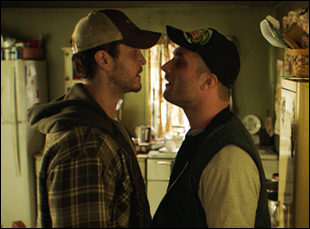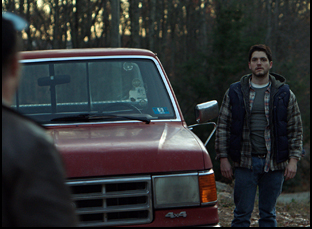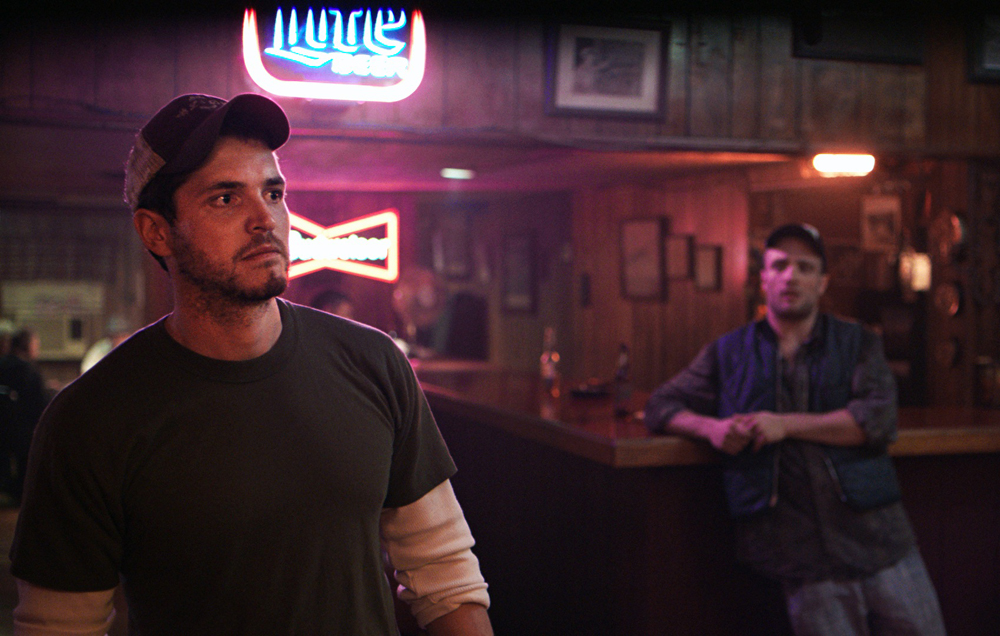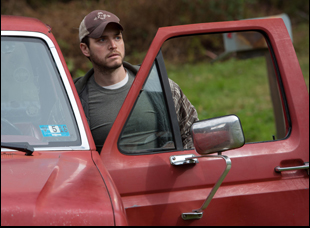Braden King was trying to work out the locations for his latest film “The Evening Hour” when he just had to pull over.
“I was driving down a little two-lane road one day by myself, and came around a bend in the road and almost ran into a ditch because I passed this little house that had a trailer on the property and had a church next door. It was like, “Come on!” King laughs now, describing his delight at finding a place almost too on the nose for his lead character who tries to extricate himself from the legacy of his grandfather, a pentecostal preacher. “Now the trailer was completely uninhabitable and we had to bring in our picture trailer, but when you have those things start to happen, you know you’ve followed the breadcrumbs to the right place.”
Of course, that takes time, which is perhaps why nine years have passed with King’s striking narrative feature debut “Here,” but the wait has been worth it as the director’s adaptation of Carter Sickels’ 2012 novel is an affecting snapshot of a town and a man who suspects there’s a better life outside of it in Cole (Philip Ettinger), a nurse who has made ends meet by trading on his access to pills to stay afloat in an ailing Appalachian community. While he’s eluded the authorities, an old high school classmate (Cosmo Jarvis) has taken notice, attempting to formalize what Cole’s been doing under the table with a moral discretion as much as a lookout for the law, and as his grandfather lays dying, Cole eyes an escape.
Yet King and writer Elizabeth Palmore broaden the canvas of “The Evening Hour” to look beyond Cole’s plight to everyone in his life, all feeling weighted down by history when family roots run so deep and moving away seems all but impossible in a place starved of opportunity. Still, there is beauty in the rolling hills and in the relationships that emerge from a shared struggle that puts a premium on compassion, with the compromises that have to be made on a daily basis revealing of character when some accept them with grace and others with rebellion and anger, and King’s empathetic lens highlights how as easy it is to slip into despair, there is just as much kindness around.
Boasting an impressive ensemble that includes Lili Taylor, Kerry Bishe, Marc Menchaca and Stacy Martin and Tess Harper, the film is making its way into theaters after premiering at last year’s Sundance Film Festival and King graciously took the time to talk about how adapting Sickels’ book required some reworking of his approach as a filmmaker, keeping himself open to the unexpected on set and the constant inspiration of the locations he films.
I was sent the book by a producer named Tom Skapares probably going back six or seven years now and instantly took a liking to it. Carter Sickels, the writer of the book, had rendered a portrait of Appalachia and its inhabitants that seemed so much more complex and nuanced and complicated than any I had seen of the region and it also contained a few things that spoke to me as a filmmaker — first and foremost, a very strong sense of place and a set of intertwining narrative strands that I found really intriguing. A lot of the projects that I’m drawn to tend to have a heavy experiential aspect to the actual production, and this seemed to have an opportunity to do something that in addition to telling a good story would have a great deal of personal life experience involved for the cast and crew and the community in which we made it.
I was going to say at that poker game early in the film, those didn’t look like your usual extras. Did you draw on the community for those scenes?
We did to a pretty great extent. My deeper background is in photography, music and anthropological film, so I’m always really interested in blurring the line between fiction and nonfiction a little bit. there’s that great line from Wim Wenders about all films being documentaries in a way and it just seemed to make sense to bring in and collaborate with the community with which we were shooting. Our background casting director was a street photographer named Alex Gillaspy, who is very talented at meeting people and he also takes beautiful photographs and portraits. We set him loose in Harlan County to go out and find some of the most interesting faces he could and a lot of those people ended up populating our scenes. A couple of them ended up with small speaking roles.
When you’re given to letting a story grow out of a location, was the process of adaptation interesting?
It was a little challenging at first because of the way I’ve worked in the past. When I was making “Here,” the film I shot in Armenia with Ben Foster and Lubna Azabal, that script grew out of a process that included a lot of travel, photography and location scouting while Dani Valent and I were writing that script and I rarely start with a fully formed story. In this case, Elizabeth Palmore, the screenwriter and I, had a deeply fruitful collaboration, but there was a little bit of a stumbling block for me when I started location scouting. My process for that ended up being spending a lot of time on my own, driving around southeastern Kentucky and western West Virginia with a camera and meeting people, trying to find the right home for the film.
There was a little bit of a tension there because normally I’m interacting with the locations even at the writing stage that going to find the bar or the compound where Cole’s family lives was initially a little bit frustrating, but then I just had to adjust my mindset and not be super-rigidly attached to what we had come up with in the screenplay. We didn’t divert radically from Elizabeth’s adaptation, but once I became a little more flexible with that, things fell into place from a creative standpoint for me and what I realized was I can still engage in that same process. I just need to start it earlier, like the way I did with “Here,” so even if it’s a preexisting adaptation or script, there’s nothing stopping me from working the way I normally do.

That’s always been the case. I really started out when I was much younger. I was a photographer and a partner in a very handmade recording studio in Chicago in the ‘90s and all of those experiences in all these different forms of media inevitably inform your approach. What happens is no matter which format you’re working in or you’re making, you’re always kind of honing your intuitive skills and as a filmmaker, I think one of the benefits of having worked in photography, having had recording studio experience, having played music is a certain fluency with how the pieces fit together when you’re making a film and having a bit more of an open mind toward a piece of score influencing an edit or looking at a film structure more as a musical score than a narrative map. I always feel like I’m operating from a little more of like a sculptural or visual art point of view than a filmmaker who is much more obsessed with drama and information.
You integrate flashbacks to Cole’s grandfather in a really interesting way – they develop a rhythm, but they aren’t immediate and have a very light touch to them. What is it like to figure something like that out?
You’re feeling it out like music a little bit and figuring out what fits where. Some of it’s very impulsive like let’s try this and throw some things on the timeline, but I’m constantly thinking about what the characters are feeling, what they’re thinking about and how we can echo that formally. Over a long period of time in sculpting the edit, we found the places reflecting the complexities of Cole’s relationship with his grandfather and the complexity of the grandfather’s role in the family, and I think there’s almost a trap to fall into.
One of the things that was very present in our minds as we were constructing this film is there’s very few, if almost no characters in the film who are all good or all bad, and at the very end of the credits, there’s a quote from a Jason Molina lyric, “The real truth about it is no one gets it right, the real truth about it is we’re all supposed to try.” And there’s a different version of this movie [where] Cole’s grandfather is a real fire and brimstone preacher or he’s a bad guy and he’s exerted too much pressure on the family, but I think we can all probably agree that our relationships with our parents, our friends, our lovers and our partners are a lot more nuanced and complicated than that. We were trying to find ways to reflect how even with people that can sometimes make life difficult for you, there’s still goodness in those relationships and trying to ride that line in a way that felt emotionally correct, but was still nuanced and complicated.

There was a woman that got up at the Sundance premiere, and I think it was the very first question in the Q & A, [where she] remarked that the movie felt like spending a couple hours with a few of her favorite country western albums and I felt like “Okay, we can end the Q & A now. Our work is done here.” [laughs] And I tell that story as a way of answering your question, which is to me, and Joseph Krings, one of the editors we worked with, that we really focused on was a kind of musical path through this location and through this story — the way their lives are woven together. There was a lot of care and effort put into trying to create a certain kind of flow through the film and it was not maybe 100 dependent on who says what and what happens, but was how it feels, so it was challenging to balance those different storylines and characters, but that also echoes what’s happening to Cole – this is a character that’s being pushed in all these different directions and is trying to find his equilibrium, so I felt like there was a neat parallel between what we were trying to do to make the film work and what Cole was trying to do to make his life work.
From what I understand you give the actors a lot of leeway to find their characters. Was there anything that you weren’t expecting that you were excited by?
always feel like part of the endeavor is clearing the runway for everyone you’re collaborating with from the actors to the crew to do their best work, acting as a sounding board and as a guide sometimes and stepping back and steering the ship if it gets a little off-course. I’m always very nervous about cutting off a good idea, so what I like to do is we’ll start a scene and the first two or three takes I don’t give any direction before we start. We may have conversations about the film together, and obviously I do auditions, but when we’re on the day, I want to see what the actors comes with first because if I jump in there and say “Okay, I think he’s angry and we’re going to do this and you’re going to walk over there and do that,” I’ve already cut off whatever they might be bringing to the table.
I’ve got my thoughts in my back pocket and I can go to those any time, but if I let the actors show me what they’re bringing to the table, we might find something that’s better than anything I could’ve imagined. So I make sure that I’m paying enough attention to know whether or not that’s better than my idea was or if we might have to try something else that’s more in line with what I might’ve been thinking, and there are a number of scenes in the film and performances in particular where I might’ve been a little bewildered by the actors’ first runs through it, but when I stepped back and compared it even to some of my ideas might’ve been, it was way better. Working in that way, what happens is you’re truly working together because the actor might do something that’s really exciting and really different from what you’re thinking and then if you just steer it a little bit to the left, this other thing happens and it becomes catalytic. I compare the on-set work a lot to surfing. It’s like these waves are coming and you have to figure out how you’re going to ride the wave, but you start fighting the wave and you’re going to lose every time. [laughs] So you have to work with what you’re being presented with whether it’s weather or an actors’ performance or a location that changed from the last time you were there and you really have to let go of the ideas in your head because if you don’t, you’re missing opportunities.

That’s a great compliment to our production designer Debbie DeVilla. One of the ironies of where we were shooting in Southeastern Kentucky is there’s a lot of dry counties where there aren’t bars, as opposed to some of the places I was scouting in West Virginia, to the point where I started to get worried about it. I thought we might actually have to build something almost from scratch, but we found this VFW hall a little outside downtown Harlan and slowly got to know the guys over there and worked our way in. It was funny because when I first visited it, I thought this might work, but I only saw the front half of the bar where you first walk in and then we came in and said hi and you take things one step at a time and get people comfortable with you. When I came back and looked at it again, it turned out there was a doorway into that whole second part where the deal goes down at the end of the movie that we didn’t know about the first time. [laughs] We ended up removing the wall where that door was so that it’s just a straight pass through, and I think we put it back at the end of the shoot.
We redressed that location pretty significantly and relit it and took a lot of the military memorabilia off the walls, but it’s a really neat location and that’s an example of the process I was talking about before where you’re collaborating with the landscape you’re encountering. That’s why I drive around so much and take so many pictures and meet people because when we finally settled in on Harlan, it was almost like the location was speaking to us.
Is it true a lot of people from Harlan made their way out to Sundance for the film’s premiere?
It was amazing and so gratifying. We had at least a dozen people from Harlan that came in for the premiere and a lot of them hadn’t done a lot of travel before. The fact that they were so interested and were proud of the film really meant a lot to all of us, and I’ve thought a lot about the fact that we give a lot of our lives to these projects and we spend a lot of time away from our loved ones and our families and if the process doesn’t have an intrinsic value and life experience to it, it’s problematic. At the end of the day, you obviously want to make the best film you can, but all you are really left with is what your day-to-day experience was and the friendships that come out of that, so I’m just so gratified that the people in the community are so proud of the film and feel we did them right and that the cast and crew had an experience that was also deeply meaningful to them. We’re going to be returning to Harlan at the end of August to show the movie there and it looks like a lot of our cast and crew are contemplating making the trip for that and it’s a good feeling to know everybody feels that way about the experience we had.
“The Evening Hour” opens on July 30th in New York at the IFC Center, August 6th in Los Angeles at the Monica Film Center, in Dayton, Ohio at the Neon, in Seattle at SIFF Cinema and Washington D.C. at the Avalon Theater and August 20th in Chicago at the Gene Siskel Film Center.





